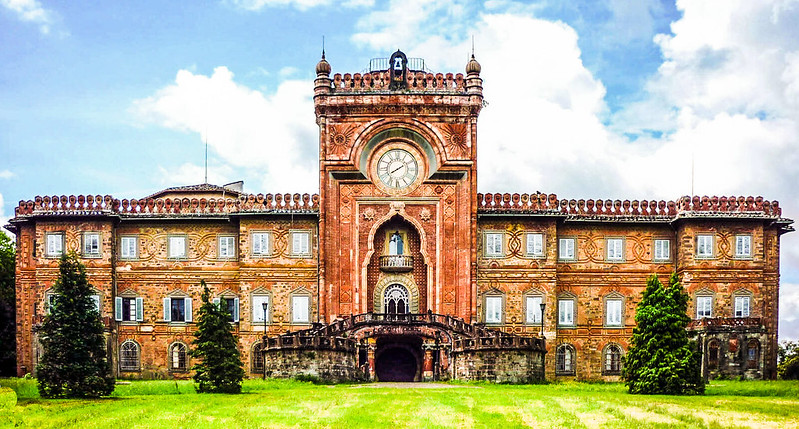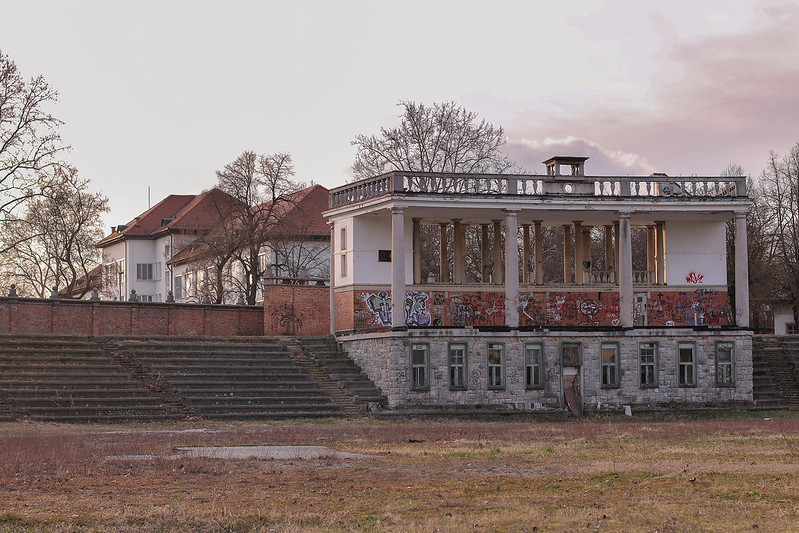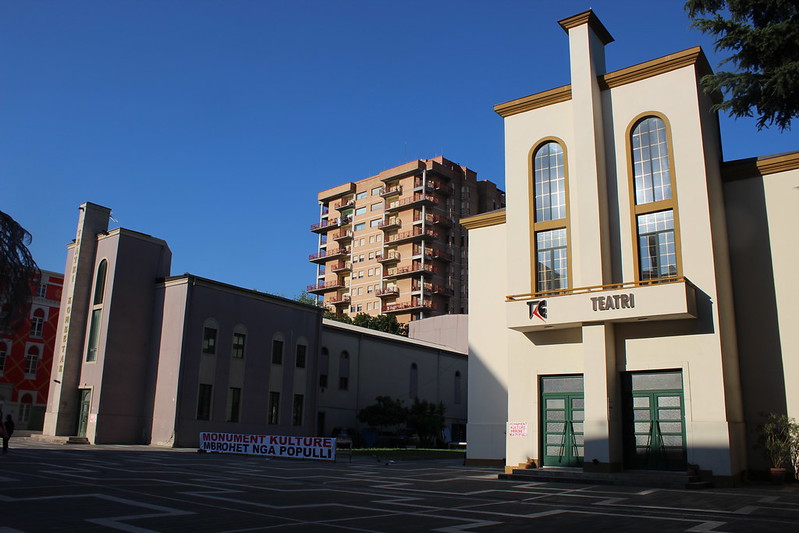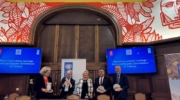14 European heritage sites shortlisted for the 7 Most Endangered programme 2020
The Hague / Luxembourg / Brussels
- An iconic government building in Oslo, damaged by the 2011 terrorist’s attack, is set to be demolished…
- An impressive fortress in Belgrade, deeply rooted in European history, is threatened by a harmful cable-car project…
- One of the most prominent cultural centers in Albania and an important social and public space in its capital, now faces the imminent threat of demolition…
- A spectacularly ornamented 19th-century castle in Tuscany has fallen victim to deterioration, neglect and vandalism…
Just four examples demonstrating the great variety of the 14 European heritage sites shortlisted for the 7 MOST ENDANGERED LIST 2020. The 7 Most Endangered programme is organised by Europa Nostra, the Voice of Cultural Heritage in Europe, and the European Investment Bank Institute. It is supported by the Creative Europe programme of the European Union.
The Shortlisted 14 endangered heritage sites are:
- National Theatre of Albania, Tirana, ALBANIA
- Karas – Traditional Wine Vessels, ARMENIA
- Khoranashat Monastery, Tavush Region, ARMENIA
- Castle Jezeří, Horní Jiřetín, CZECH REPUBLIC
- Tapiola Swimming Hall, Espoo, FINLAND
- Castle of Sammezzano, Tuscany, ITALY
- Archaeological Park of Sybaris, ITALY
- Ivicke House, Wassenaar, THE NETHERLANDS
- Y-block, Government Quarter, Oslo, NORWAY
- Szombierki Power Plant, Bytom, POLAND
- Belgrade Fortress and its surrounding, SERBIA
- Plečnik Stadium, Ljubljana, SLOVENIA
- Cuatro Caminos Metro Depot, Madrid, SPAIN
- Egyptian Halls, Glasgow, UNITED KINGDOM

Nominations were submitted by civil society or public bodies which form part of Europa Nostra’s network of member and associate organisations from all over Europe. An advisory panel, composed of 15 international experts, selected the most endangered heritage sites on the basis of their historic and cultural value and the urgency of the threat they are facing. It also takes into account the community engagement, the commitment of public and private stakeholders, the long-term sustainability and the socio-economic potential of the site.
The final list of 7 most endangered heritage sites in Europe will be announced in March 2020.
The 7 Most Endangered programme, launched in January 2013, is a civil society campaign to save Europe’s endangered heritage. While not providing direct funding, it raises awareness, prepares independent assessments, proposes feasible action plans to mobilise public and private support. You can read about the positive impact of the scheme here.
14 European heritage sites shortlisted for the 7 Most Endangered programme 2020
(listed in alphabetical order of their country)
National Theatre of Albania, Tirana, ALBANIA
The National Theatre of Albania, one of the most prominent cultural centres in Albania and an important social and public space in its capital Tirana, now faces the imminent threat of demolition. The Theatre, built in 1938-39, is an outstanding example of modern Italian architecture from this period and is an integral urban component of the monumental central axis of the city. The construction technique was based on the use of prefabricated panels with cemented wood fibre as part of the Autarky movement in Italy and is considered innovative for its time.
Europa Nostra has already publicly expressed its sincere concerns regarding the decision to replace the Theatre with a new contemporary building. Plans to destroy it have been met with popular protests supported also by experts, who are urging the city to make full use of the Theatre’s existing potential for the cultural and social enrichment of Tirana. The nomination of the National Theatre by the Gjirokastra Foundation is part of this wide civil society campaign to save the building.
Karas – Traditional Wine Vessels, ARMENIA
Traditional wine-making techniques in Armenia are at serious risk of being lost. Distinctive clay vessels known as “karas” have been used in the tradition of winemaking in Armenia for more than 6000 years. This practice eventually spread across the entire reaches of the Mediterranean, as evidenced by archaeological findings.
The distinctively shaped karas are made by master potters with an intricate system of coiling and can contain up to 1500 litres of liquid. Despite the ubiquitous part they have played in Armenia’s wine culture, the traditional techniques and knowledge of making karas are now at risk of being lost.
The nomination was made by the Karas Revival Heritage Foundation, an organisation which is focused on the revival and transmission of the knowledge of karas making. A project towards the conservation and valorisation of this traditional craft could lead to positive outcomes in terms of education among the local community and places an emphasis on the important connection between tangible and intangible cultural heritage.

Khoranashat Monastery, Tavush Region, ARMENIA
Khoranashat Monastery is an outstanding example of Armenian architecture from the Middle Ages, found in the north-east of the country, very close to the border with Azerbaijan and surrounded by a forested landscape. In the past, it was a noteworthy cultural centre, hosting both a monastery and a university. Today, the church still functions as the only place of worship for the nearby villages of Chinari and Aygedzor.
Of the numerous buildings built in the Middle Ages, only the church of Sourp Astvatsatsin and the little church of St. Kiraki are conserved, both in a severe state of deterioration and suffering the effects of inappropriate past restoration work.
The site is threatened both by its physical and political context. Its isolated location in a seismic zone that is prone to landslides makes conservation work especially challenging while the ongoing conflict at the border of Armenia and Azerbaijan poses considerable risks to visitors.
The Ministry of Education, Science, Culture and Sport of the Republic of Armenia is the nominator while the Swiss organisation Il Germoglio is already engaged in charity work in Armenia and this region and is committed to supporting a conservation and management plan to revitalise the site.

Castle Jezeří, Horní Jiřetín, CZECH REPUBLIC
This vast Baroque castle is in an extensive state of deterioration. Intensive mining activity in direct vicinity of the castle has further aggravated structural issues over the mine’s 100 years of activity and has seriously altered the castle’s natural setting.
Formerly a seat of the Lobkowicz family, Castle Jezeří was an important cultural and social centre in the 18th and 19th centuries. Many acclaimed figures were hosted there and it was the scene of the first private performance of Ludwig van Beethoven’s third symphony in 1804. In more recent times, the castle suffered the effects of total neglect leading to the advanced decay it faces today.
The castle serves as one of the few surviving mementos of the many historic structures and natural landscape which were lost to the mining activity. The most nearby historical city centre, for example, was completely erased and the castle itself had almost suffered a similar fate.
The sheer size of the building means that a long-term and costly project is needed to revitalise it. The nomination of the castle was made by the Czech Association of Castle and Manor House Owners and is supported by its owner, the National Heritage Institute.

Tapiola Swimming Hall, Espoo, FINLAND
One of the most significant examples of post-war modern architecture in Finland is now at risk of being lost due to the serious deterioration of its materials. The need for repair and consolidation of the concrete structure has been deemed too costly for the owner of the building, who favours the demolition of the Tapiola Swimming Hall with a new structure to be built in its place.
Tapiola was one of the first post-war “new town” projects in Europe and its design follows the philosophy of the garden-city movement in urban planning. The centre of Tapiola consists of buildings of different functions. At the heart of the centre is a large artificial lake surrounded by a cultural centre, a tower, a church, a hotel and swimming hall. As such, the Tapiola Swimming Hall, designed by the architect Aarne Ervi and completed in 1965, is symbolic of European ideals of urban planning in post-war Europe.
The nominator of the site, Europa Nostra Finland, calls for the restoration of the building, which would in turn guarantee the integrity of the city’s urban character.

Castle of Sammezzano, Tuscany, ITALY
This richly decorated castle in Tuscany continues to be at risk of deterioration following its shortlisting for the 7 Most Endangered programme 2016. The striking, much-loved building is rare in Europe thanks to its eclectic combination of styles, typical of the Orientalist fashion which was popular at the time of its construction in the late 19th century.
The strong influence of Islamic architecture is evident, with intricate white stucco, dazzling, vibrant colours and geometric patterns used in its interior decoration throughout. The castle is also notable for its surrounding park of 470 acres which is home to a wide variety of tree species including 57 giant sequoias.
Lack of maintenance, vandalism and theft threaten the future of the building, with its condition worsening with each passing year. Many of the outstanding elements of this special building are at risk of being irreversibly lost. In addition to the nominator of the site, Imago Mundi Onlus, there are many partners in the campaign to secure the future of the building, including the Save Sammezzano Civic Movement.

Archaeological Park of Sybaris, ITALY
The archaeological site of Sybaris is one of the most important archaeological sites in Southern Italy. Only partially excavated, the site includes the remains of the archaic settlement founded in the 7th century BCE and destroyed by Kroton in the 6th century, the classical city layout designed by Hyppodomus of Miletus, and the later Roman settlement.
The site faces the challenge of groundwater covering most of the remains and by the flooding of the River Crati.
Although the site has recently benefited from a major investment to improve the conservation, accessibility and enhancement of the remains, it remains endangered. The threat of rising groundwater levels as a result of climate change could further deteriorate the situation.
The nomination by Italia Nostra highlights the need for a more effective governance and management of heritage and touristic potentials. The Advisory Panel of the 7 Most Endangered has shortlisted the Archaeological Park of Sybaris to aid in defining immediate and mid-term effective actions. The decision of the Advisory Panel came a few days before the Italian Ministry of Culture granted the site a new status to enhance appropriate management of the archaeological park and museum.

Ivicke House, Wassenar, THE NETHERLANDS
Ivicke House, located just a few kilometres from the city of The Hague, is at increased danger of disrepair due to lack of maintenance on the part of its private owner.
Built in 1913 in a French neo-Louis XVI style, the house is a faithful imitation of the Hermitage Hunting Lodge located in the forest park of Dyrehaven, north of Copenhagen.
Ivicke House has been left to deteriorate for about two decades and is increasingly exposed to the elements through broken windows, leaks in the roof and gutters and through infiltration of its walls.
The private owner of the site has been steadfast in refusing to carry out anything aside from the most minimal repairs to the building, in direct contravention of the National Monument Law which states that owners of buildings of heritage importance must appropriately maintain their property. Squatters who have occupied the building since July 2018 have carried out some emergency repairs.
The nominator of the site, Bond Heemschut – the Association for Heritage Protection has been working in parallel with the Stichting Cuypersgenootschap – Cuypers Society in their campaign to save Ivicke House.

Y-block, Government Quarter, Oslo, NORWAY
The Y-block, an iconic government building with symbolic significance, now faces the imminent risk of demolition.
The Modernist building was designed by the architect Erling Viksjø and was built in the 1950s. Towards the end of its construction, Pablo Picasso designed two murals for the decoration of the building in the innovative sandblasted concrete technique, a new method developed by the building’s architect and the artist Carl Nesjar. “The Fisherman”, found on the facade and “The Seagull”, located in the interior, are rare examples of public art produced by Picasso.
In 2011, a Norwegian terrorist detonated a bomb in The Government Quarter, killing 8 and injuring 200, before travelling to the youth camp of the Norwegian Labour Party where he murdered 69 young people, injuring a further 66 victims.
The buildings withstood the attack, and the site now acts as a memorial to all victims of the attacks. They are a symbol of the resilience of the democratic values that the terrorist failed to destroy. Fortidsminneforeningen – The Society for the Preservation of Norwegian Ancient Monuments renewed their nomination of the building to the 7 Most Endangered following its shortlisting in 2016, to halt the plans to demolish the building.

Szombierki Power Plant, Bytom, POLAND
A Modernist power plant with huge potential for reuse is threatened by the risk of demolition. Szombierki functioned for almost 80 years and is one of the last hard-coal powered electric power plants in Europe. For the past two decades, it has been vacant and slowly deteriorated in spite of several efforts to turn the site over to cultural uses.
The monumental Modernist architecture is characterised by its grand facades of dark red brick and its three slender chimneys. In size and capacity, it can take inspiration from similar power plants found in the United Kingdom, such as the Battersea Power Station and the Bankside Power Station (Tate Modern), both of which have been successfully converted to cultural use.
Leaking roofs and windows together with vandalism and theft have accelerated the degradation of the site. Little maintenance has been carried out by the private owner, nor financing been made available to adapt the site to new uses. If solutions cannot be found for Szombierki, the plant will face demolition.
The Foundation for the Protection of Silesian Industrial Heritage, the nominator of the site, supports the preservation of this important and representative element of Silesia’s industrial heritage.

Belgrade Fortress and its Surroundings, SERBIA
The Belgrade Fortress, an iconic symbol of the city, is threatened by a harmful cable car project which would drastically compromise the integrity of the site.
The Belgrade Fortress is one of the most important cultural monuments in the Republic of Serbia, with the Fortress and its surrounding landscape having borne witness to the presence of humans since the Neolithic Period, as evidenced by the remains from Celtic, Roman, Byzantine, Hungarian, Bulgarian and Serbian Middle Age periods as well as the Ottoman and Habsburg Empires.
The Belgrade Fortress and its Roman archaeological heritage (Ancient Singidunum) are on the Tentative List of UNESCO as part of the biggest pan-European transnational world heritage property, the Frontiers of the Roman Empire. The Kalemegdan Park, located at the Fortress, is much loved by the city’s residents and its extraordinary position overlooking the confluence of the Sava and Danube rivers offers protected viewpoints of outstanding beauty. The nominator of the Belgrade Fortress and its surroundings was made by Europa Nostra Serbia.

Plečnik Stadium, Ljubljana, SLOVENIA
Unsuitable development plans are set to severely alter the integrity of the Plečnik Stadium.
Constructed in 1925, the Stadium is one of the earliest sites built for sports and gymnastics purposes in Slovenia and is one of the earliest buildings of its kind in Europe. The open-air facility takes its horseshoe shape from ancient amphitheatres and consists of the arena, raised tribunes, a colonnade on the eastern side, a tribune with columns on the western side and two music pavilions. It is a masterpiece of the architect Jože Plečnik.
Plečnik is credited with shaping the city of Ljubljana and is widely regarded as one of the most significant architects of the 20th century in Central Europe. Each of Plečnik’s buildings is designated with a special heritage status in Ljubljana.
Until 2007, the stadium was in regular use. The new company plans to remove almost all original elements of the stadium and to build a new stadium in its place. New structures which would include hotel rooms, offices and commercial units have also been planned.
The nominator of the site, the Association of Architects Ljubljana endeavours to preserve the Stadium in its current form.

Cuatro Caminos Metro Depot, Madrid, SPAIN
After more than 100 years of continuous use, this metro depot in the northern neighbourhood of Cuatro Caminos in Madrid now faces the threat of demolition to make way for a large apartment building.
This depot was the first that was built for a metro system in Spain. It is rare in Europe and the rest of the world for its borrowing of the architectural typologies of the New York subway system, such as the sawtooth roofing used in its sheds. As such, it is an essential part of the history of the Madrid Metro.
Though some sheds from the depot have been lost, the remaining structures are relatively well-preserved. Its misuse and lack of maintenance however, coupled with the use of inappropriate materials, such as asbestos, mean that urgent intervention is needed.
The Fundación Ars Civilis is the nominator of the site and campaigns for the recognition of the depot as a vital element of Madrid’s history.

Egyptian Halls, Glasgow, UNITED KINGDOM
Having now stood vacant for almost 40 years, Glasgow’s Egyptian Halls, a masterpiece of the architect Alexander Thomson, is increasingly confronted with the danger of being completely lost.
Completed in 1872, the building hosted public gatherings and musical performances, and was home to over 50 stalls selling goods from around the world. The five-story building was built in a Classical style with an unusual combination of Greek, Egyptian and Assyrian detailing.
The ground floor units have been used consistently as shops while the upper floors have gone through numerous changes and neglect in recent years. Water penetration, poor alterations and an inappropriate use of materials have combined to advance the building’s deterioration. Though the majority of the interior design has been lost, the building’s principal facade remains almost intact.
Planning permission has been granted on several occasions to convert the building into a hotel, but these have stalled due to a lack of available public funding to support a commercial development.
The Society for the Protection of Ancient Buildings nominated the site with the support of the Alexander Thomson Society, who support research into finding a realistic alternative use for the building.

Background information
Europa Nostra is the voice of civil society committed to safeguarding and promoting Europe’s cultural and natural heritage. A pan-European federation of heritage NGOs, supported by a wide network of public bodies, private companies and individuals, it covers more than 40 countries. Founded in 1963, it is today recognised as the most representative heritage network in Europe. Maestro Plácido Domingo, the renowned opera singer and conductor, is the President of the organisation.
Europa Nostra campaigns to save Europe’s endangered monuments, sites and landscapes, in particular through the 7 Most Endangered programme. It celebrates excellence through the European Heritage Awards / Europa Nostra Awards. Europa Nostra contributes in formulating and implementing European strategies and policies related to heritage, through a participatory dialogue with European Institutions and the coordination of the European Heritage Alliance 3.3. Europa Nostra was one of the instigators and organisers of the European Year of Cultural Heritage 2018.
The European Investment Bank Institute (EIB-I) was set up within the EIB Group (European Investment Bank and European Investment Fund) to promote and support social, cultural, and academic initiatives with European stakeholders and the public at large. It is a key pillar of the EIB Group’s community and citizenship engagement.
Creative Europe is the EU programme that supports the cultural and creative sectors, enabling them to increase their contribution to jobs and growth. With a budget of €1.46 billion for 2014-2020, it supports organisations in the fields of heritage, performing arts, fine arts, interdisciplinary arts, publishing, film, TV, music, and video games as well as tens of thousands of artists, cultural and audiovisual professionals. The funding allows them to operate across Europe, to reach new audiences and to develop the skills required in the digital age.
Elena Bianchi
Europa Nostra
eb@europanostra.org
+31 70 302 40 55
Bruno Rossignol
EIB-I
bruno.rossignol@eib.or
+352 43 797 07 67







